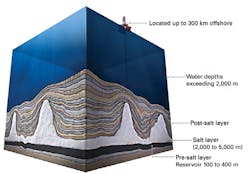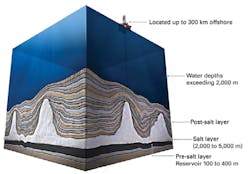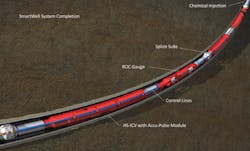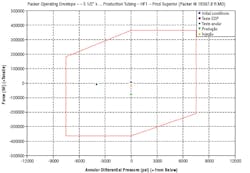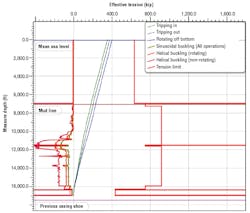Intelligent completions play key role in Brazilian presalt development
Technology helps deepwater remain competitive
D.N. Rodrigues
L.B. Minassa
R.S. Nunes
L.C.P. Costa
Halliburton
The current landscape for the oil and gas industry is challenging because of pressure associated with costs. Various different business models are surging with short cash flow cycles, and most of the deepwater asset development plans should be reassessed for viability in current market conditions. Significant effort is being made to adjust the current supply chain cost for the deepwater market to make it competitive again.
One of the most important challenges that deepwater faces compared to other projects is related to the cash flow cycle that demands significant investment up front, with a significant recovery period. With this challenge in mind, operators are pursuing ways to accelerate development of deepwater assets and highlighting uncertainties related to the project decision making processes. However, in the midst of this cost pressure, completion design is a crucial tool for reducing the cost per barrel of oil produced by eliminating well construction costs and increasing the production from such wells.
The Brazilian presalt presents a number of challenges to development, including low seismic resolution, thick salt zones, compositional grading, and high CO2 content. (All images courtesy Halliburton, except where noted)
Additionally, operators are trending toward a reduced number of wells with longer operating life and increased productivity. A way to mitigate the risk of such well reduction in the overall number of wells involves focusing on reliability, proper reservoir management tools, and production risk predictability. It is important to maintain the ultimate oil recover factor of the fields because this metric is one of the most impacting on net present value (NPV) of such long-term developments.
The Brazilian presalt is a relatively young cluster with unique challenges and many uncertainties on its subsurface. Low seismic resolution under thick salt zones, compositional grading, variable GOR, high CO2 content, organic and inorganic depositions and very thick microbial carbonates were uniquely blended, making it hard to predict its behavior under dynamic production conditions.
Despite those risks, a decision was made to fasttrack its development, even though the understanding of the impact of such uncertainties on field production was unclear. One of the technologies chosen to help mitigate those uncertainties and provide flexibility in terms of reservoir management was intelligent completions. This bold decision proved successful, even though some bottlenecks were later identified.
To help reduce risk associated with the application of intelligent completions, it was decided to use a standardized well design using a direct hydraulics stacked dual zone intelligent completion. Each interval was comprised of a multi-feed-through (control line channels) packer, interval control valves (ICVs), permanent downhole monitoring of pressure and temperature, and a dedicated chemical injection system for the producer wells and splice clamps. Additionally, flatpacks were installed to transmit fluid from the wellhead to the downhole tools and cross-coupling protection clamps were installed to protect those lines. Lastly, a surface interface control system integrated with the subsea control station was deployed. Standardizing the subsea layout and interface and reducing the uncertainties associated with well design allowed for a steep learning curve to be achieved and improvements to be built upon. However, with advancements in understanding its applicability and some new well construction risks, this decision to standardize has some limitations and newer concepts are being developed for future wells.
Ultra-deepwater challenges
Most ultra-deepwater projects worldwide are facing similar challenges, where significant decisions must be made without a complete understanding of production. Most of this accelerated decision making is driven by the need to improve the cash flow cycle, this includes those presalt fields under exploration and those not being awarded by a Brazilian National Petroleum Agency (ANP). Many operators tend to navigate toward the simplest completion design possible to mitigate installation risks and reduce capex. However, because of the lack of reservoir predictability, they most likely are going to face unexpected production of unwanted fluids, and caught with few resources downhole to address it without incurring significant opex from workover operations. Intelligent completions have proven that having remote actuation capability allows for faster decision making to counter nature’s unpredictability. The benefits of the application of intelligent completions have been quantified by many, but one assessment assessed that the technology could deliver a quantified value of $5 billion of added value. The ultimate value of its application is derived from the expected increase in the ultimate recovery by, prolonging production from a given interval, improving reservoir sweep efficiency, and reducing the production of unwanted fluids.
However, the current state of the technology also brings challenges to well planning and requires additional steps and precautions during the completions phase that impact application cost. Most of the preconceived ideas regarding intelligent completions are based on past experiences where failures were related to poor planning or poor execution leading to significant increases to installation costs. Even though use of intelligent completions was high, presalt completion time has been significantly reduced compared to the early stages of those fields’ development. Those results prove that, with proper management, it is possible to achieve very competitive construction times with the technology. It is important to highlight that material selection and flow assurance are important risks both for cost control and well productivity, and extensive work must be performed to ensure that the equipment realizes the design lifetime as planned and that corrosion, erosion, and inorganic deposition are well accounted for during the planning phase and will not hinder well productivity. An important planning phase is to determine the composition of the completion hardware metallic components, because of the contaminants in the produced oil, such as high CO2 and the risk of H2S production; corrosion resistant alloys (CRAs) were chosen as a standard for the presalt fields. Additionally, it is important to account for erosion of the equipment when in production. Scaling of calcium carbonate was identified early as a crucial factor for success and studies were performed to better understand its formation in the ICVs.
A significant number of decisions can affect the ability of this technology to work properly. Of particular importance are subsea infrastructure and wellhead capabilities. Considering intelligent completions early during field development planning allows for the possibility of properly addressing unforeseen reservoir management techniques. Most of the restrictions to applying intelligent completions in deepwater fields are related to the subsea wellhead design that was selected early in the project.
A crucial point here is the correct usage of the intelligent completions technology. Even with proven potential value-added benefits from its application, the system by itself is not going to aggregate the expected value if not properly used and understood. It is important to understand the system’s limitations and its dependence on the whole control system to properly function ICVs and maintain the system availability. The system is only to going to pay itself if used properly and, when possible, proactively. Even though many production engineers are reluctant to manipulate the system due to a very conservative mindset, an important part of this reluctance comes from a lack of knowledge of or trust in the technology. One of the ways confidence can be fostered is through fit-for-purpose equipment selection based on proven performance and intrinsic reliability, increased control system flexibility, and by using digitalized real-time modeling, sometimes referred as digital oilfields. The last is supported by the increased monitoring and control capability in the completion allow simulations to be performed that better support the decision-making process providing confidence and forecasting the potential benefits of manipulating the system and implementing flow optimization.
Equipment selection
As discussed previously, the completion design was standardized as a dual zone stacked intelligent completion; however, some variations were used in specific cases. The environment was ultra-deepwater with depths ranging from 2,100 to 2,300 m using dynamically positioned rigs. Wells were cased with a combined 9 5/8-in., 53.5 lb/ft with 8.500-in. special drift and 10 3/4-in., 85.3 lb/ft casing. Each interval was perforated using tubing conveyed perforating (TCP) guns into two sections in one shot. Perforated length typically surpassed 100 m per interval. Wells were typically vertical or deviated to a maximum of 50°, with the maximum dog leg severity under 3° per 100 ft.
Because of high CO2, ranging from 20 to 60% in volume, associated with produced stream and possible H2S (50 ppm) being produced from the reservoir, super duplex stainless steel (SDSS) was selected as the base material, and upgrading to nickel alloys where needed. ISO 15156 and NACE MR0175 were used as reference for material selection because of the sour service nature. The decision criteria on material selection were also based on mechanical and erosion analysis performed on an individual part basis.
For such critical applications, the completions hardware must be machined from billets without any welding in the manufacturing process. Only annealed bars can be used for part machining because of the high likelihood of residual stresses distorting parts after the machining process and compromising the tight tolerances of the parts. Currently in the market, SDSS bars are only available in 80,000 or 85,000 minimum yield strength and, where parts require higher mechanical properties, nickel alloys were chosen to provide higher minimum yield strength (110,000 psi or higher) when building crucial load bearing components.
Direct hydraulics was chosen as a control system based on simplicity, extensive track record, and reliability. The system architecture chosen is an N+1 type, where N is the number of ICVs. In such a scheme, a single line is used to close all ICVs. The standard tubing size for the bottomhole assembly was 4 ½-in., 13.5 lb/ft, using premium threads with a minimum internal diameter of 3.75 inches. Each interval has one multi-position ICV for inflow or outflow control purposes. The ICVs are hydraulically actuated sliding sleeve type valves that control flow between the annulus and tubing with eight choking positions. To achieve the choking capability, a control module is included to restrict the amount of fluid that exits the piston chamber of the ICV, which controls the linear movement of the inner sleeve. This sequence allows the ICV to incrementally open to previously calibrated choking positions. In terms of the closing direction, the ICV is capable of closing in one stroke from any position. This unique feature can be used to bring the ICV to a reset position that can be confirmed by pressure signatures of the permanent monitoring and control systems.
The ICV is the main downhole means to modify inflow or outflow for a given interval and can be considered the active reservoir management tool of intelligent completions; this is the reason that failure modes associated with the valve must be considered and mitigated where possible. To simplify them, two main categories were established—design related risks and external factors. To mitigate the design related risks, proper design and a robust qualification process should be implemented to help ensure the tool is going to perform predictably in a given operational envelope.
Load analysis of packer envelope.
Additionally, care should be taken when deploying those systems to ensure that they are going to reach planned depths without damage to the tools or control lines. A second mitigation plan is to evaluate the loads and wearing mechanisms the valve is going to be subjected to. One of those wearing mechanisms is erosion, an operational plan is necessary to help ensure flow velocity thresholds are not surpassed when the valves are subjected to production or injection of fluids. Inorganic deposition (scale) was identified as a potential risk for valve failure, so a dedicated chemical injection system associated with the ICVs deploying scaling inhibitors was established for producer wells. Also, as part of the flow control system, multifeed-through packers were selected as production packers to isolate the upper and lower intervals. Both packers were permanent 9 5/8-in., 53.5 lb/ft packers with 4½-in. tubing size, and hydraulic set by tubing pressure application with no body movement. Because of the nature of the different projects, two packer designs were used with success. The main difference between the two packers was the retrieval method. The MFT packer uses a cut-to-release system, using either a chemical or mechanical cutter. The second model, the HF1, has a shift-and-pump to release design, requiring a special shifting tool to be run to the packer depth for the releasing mechanism to be activated.
Data and results
Each interval is made up into a single assembly comprising all of the pieces of equipment necessary for that specific zone in an onshore facility. The two main reasons for this approach is the reduction of work performed on the rig by offshore personnel and the reduction of risk associated with protecting the lines over the equipment on the rig floor. The process requires the lines to be run along the packers, ICV, gauge mandrels, and routing the control lines can be time-consuming and risky when performed on the rig floor. All connections are centralized in splice subs, allowing for multiple connections between the assembly lines and the flatpacks to be performed simultaneously, reducing the online time at the rig floor. Each line has its designated function—open upper ICV, open lower ICV, or close ICVs, for example, the individual lines in the flat pack were color coded to facilitate the identification process and minimize swapping lines when splicing the capillary tubing to the assemblies and the tubing hanger. The position of each line must be planned to match the planned sequence of line functions in the flatpacks. The standardization of well design and material allowed the onshore preparation process to be optimized for time and quality. Initially, an average of 25 days to prepare a full equipment set was considered necessary. Recently, the preparation time has been reduced to seven days in some instances without any compromise to the quality of the activities performed.
The production packer underwent tubing load modeling because no tubing movement compensation system that allows control lines to bypass was available. The packer must withstand the loads transferred from the tubing over the planned operations and well production, such as buckling, ballooning, thermal expansion, and piston effects. The simulations were necessary to confirm the fitness of the packer for the well design.
Additionally, to predict the behavior of the system when running in hole (RIH), torque and drag analysis were performed as part of the planning phase. When running a deviated well, the job preparation requirements are reviewed and the simulation is used to compare with actual values measured during each operation.
The expertise of the offshore personnel is crucial to success. When the campaign began back in 2013, very few specialists were available in country. Local talent was selected to be trained overseas. Operational leaders were sent to a variety of countries, such as Norway, USA, Qatar, Kuwait, Brunei, and Russia to acquire hands-on knowledge to ensure proper procedures were understood and followed to ensure smooth deployment and fasttrack operational experience. The expertise acquired was then replicated to new hires and additional personnel locally.
An important performance measure of the intelligent completions offshore crew was the online rig floor time necessary to prepare the BHA for the RIH. The time evaluated measures the moment the intelligent completion is rigged up until all connections have been made on the BHA and it is ready to be deployed with the tubing. This is an important measure because it removes most third-party activities from the evaluation and it is the most crucial phase of rig floor preparation.
However, performing faster on the rig floor is not necessarily a good measurement unless it is attached to an overall quality control KPI. In 2013, a major incident occurred in the second well being installed; a control line was damaged close to reaching final depth. The completion was pulled out and the backup equipment had to be deployed. The main cause was poor protection of one control line, which was damaged during deployment. Several measures were implemented which have proven successful since there has been no recurrence. After almost two years (2014 and 2015) without any nonproductive time (NPT), NPT was incurred resulting from service equipment failures, primarily related to a spooling unit that broke down in service.
Additionally, one of the flatpacks deployed was discovered to have a manufacturing defect detected during the RIH procedure. The damage was inspected and evaluated and, after consideration of the impacts, the damaged section was removed and the operation continued. Considering the complexity and extent of work necessary to deploy each system and the amount of NPT attributed to the technology related services, it can be concluded that, overall, the technology is very reliable for deployment, even in an ultra-deepwater scenario.
Current trends
Although the standardization of equipment played an important role in the success of the campaign, this standardization is beginning to limit the ability to adjust to upcoming reservoir control and monitoring needs. The high permeability of the presalt carbonates allows for extremely high production rates (more than 40,000 boe/d). However, the high permeability imposes the risk of severe fluid loss during the completions phase. The current design is not suitable for such scenarios as loss control material can impact functionality and deployment. Also, because of the use of flatpacks through the entire length of the well, it is currently not feasible for a managed pressure drilling system to be used to deploy intelligent completions. This increases the need to control losses before starting to deploy the system. This requirement is leading to a new well design being developed such that the well will be isolated when running the intelligent completions or to allow a dual trip deployment of the intelligent completions. For the first alternative, a lower mechanical selective system is planned to be deployed. For the second option, a downhole disconnect system would be necessary. To achieve this, new technology has to be developed.
One of the challenges faced by new designs is the ability to be deployed in an 8.5-in. openhole section. The well with the reservoir section in an open hole would save well construction time; however, care should be taken when deploying intelligent completions in the openhole section for two primary reasons. The first is the risk of damaging the control lines when traveling into the open hole; this can be prevented by increasing control line protection in the openhole interval. Deploying intelligent completions in open hole is not unique; however, proper well cleaning must be performed before deploying the completion. The second risk is the ability to isolate zones within the openhole section after the acid stimulation is performed. It has been reported that isolation was lost in some cased and perforated sections during the stimulation and the risk of the same happening in the openhole section is even greater. The isolation barrier would also need to be a feedthrough design, which is not yet readily available in the market isolate a carbonate reservoir. The isolation is also a challenge when the variable permeability of carbonates is considered. Proper placement of the openhole isolation system must be carefully selected to ensure that isolation is achieved and maintained. If the number of intervals is increased for reservoir management reasons, the challenge of maintaining isolation between the zones becomes more difficult. However, even considering all the challenges associated with this scenario, the benefits in drilling time reduction and greater reservoir exposure is paying off and operators are moving toward this approach for future field development. This approach will likely increase the fluid loss risk and increase the desire to find a solution for the excessive fluid loss discussed previously.
Another important aspect of the presalt development that is becoming more relevant is individual well production. To improve the economic returns of the presalt fields, fewer wells are being planned and the productivity of those has to increase. Among several possibilities, the two most important are increasing production per well, pushing toward 100,000 boe/d, and reducing production losses caused by equipment or systems failure. There are several challenges to safely increasing the average output per well and many of those require new technological developments to be overcome. The impact of such a high flow rate on the completion is not fully understood and the availability of big bore completion equipment is limited. Because of the low viscosity and high GOR, vibration can also become a significant failure mode, particularly for control lines. However, there are some potential areas of improvement, increasing the zonal density can help sustain high production levels for longer periods and also minimize water or gas breakthrough by shutting in trouble zones. Another possibility is using multilateral technologies. Multilateral technology has evolved and can be combined with sand control systems, such as gravel packs and frac packs, and can be integrated with a multibranch control coupled with multizone (3+) intelligent completions.
Effective tension by measured depth to evaluate buckling risk during deployment.
Additionally, the industry is adopting reliability language and analysis methods for completions hardware. Many efforts are in progress among operators and service companies to determine a baseline for reliability metrics, and also normalize the reliability language and concepts among stakeholders. For this effort, collaboration with other industries that are more advanced in this field is crucial. This is a step that must be taken and the prize for the industry is high. With fewer wells and higher production from each well, the economic impact of failure can exceed hundreds of millions of dollars in production losses.
The control system used for this campaign was direct hydraulics. This can be considered the simplest method to control the intelligent completion because of its flexibility, ease of understanding, reliability, and extensive track record. For the applications in the presalt case, transient pressures due to control system actuation play a significant role in the time necessary to manipulate the intelligent completions. The pressure source is normally supplied at the wellhead with accumulators. Even in this scenario, the pressure has to travel through more than 3,000 m of 0.152-in. internal diameter line. This slows the response time of the ICV significantly.
Additionally, no downhole sensors that allow for tool face pressure measurements or direct position reporting for the ICV were installed. This lack of instrumentation has hindered the troubleshooting and root cause determination in some isolated instances, making it very difficult to develop and apply corrective measures. Considering also that only two intervals were accommodated during the planning phase, the number of control lines was not a restriction. Producer wells also require chemical injection systems with dedicated lines to be deployed alongside the intelligent completion equipment, adding a significant number of lines. However, some presalt reservoirs may require additional compartmentalization to better manage water or gas breakthrough throughout the life of the well. Because of some wellhead design considerations, increasing the number of available penetrations is very difficult. To date, this has been limited to injectors where the chemical injection system is not required. Nonetheless, if new presalt wells require additional compartmentalization, then a new control system should be considered. Implementing a multiplexed system using downhole electronics to control the ICV movement is the best solution. In addition to improved control and faster response time, bringing the electronics downhole allows for improved monitoring of the completion and can be used to facilitate deployment of new reservoir monitoring technologies. The system can evolve to be a single control scheme for all the remotely actuated valves in a well, meaning that chemical injection valves and even downhole safety valves could be controlled safely by the same system. To effectively implement this vision, reliability becomes a significant concern and the qualification process of such a control system must be robust to quantify the controller for the expected life of the system.
Multiplexed control systems are normally divided into two categories: the hybrid, which uses electric cables for communication and powering electronics and sensors downhole, but uses hydraulic fluid as a motive force for the ICVs. This system provides a simple, but elegant solution for the downhole power system. The second system, often referred to as an all-electric system, is in fact either electro-mechanic or electro-hydraulic, with a single electrical interface at the wellhead. The electric system uses the electric power for communication, and actuations downhole. The main difference resides on the wellhead interface.
For hybrid systems, the wellhead needs to provide both hydraulic lines and an electric line. A downhole electro-hydraulic system has a built-in hydraulic power supply downhole to move hydraulic ICVs. The electro-mechanical system converts electric power to mechanic movement to actuate downhole valves directly. Evaluating existing technologies, hybrid systems and electro-hydraulic systems tend to provide more force to the ICVs, allowing them to more easily overcome eventual inorganic deposition when compared to electro-mechanic systems. Also, bringing more equipment downhole leads to a reduction in reliability if the system architecture does not incorporate redundancy. Nevertheless, eliminating the need for such hydraulic systems in the wellhead can significantly affect the economics of a field when compared on a system level because a purely electrical wellhead interface can significantly reduce the capex necessary when compared to an electro-hydraulic multiplexed wellhead.
This also follows the trend to increase the activity level at the seabed, including boosting, separation, reinjection, etc. Those technologies, when applied, will require a more refined control of the well and can require additional downhole control of the flow behavior. These concepts and trends will be most easily adopted when electric downhole control systems are developed and meet a well establish system level reliability target. Also, scaling and organic deposition pose a significant risk for the electric wellhead because there is not an available technology that is as effective as continuous injection of scaling inhibitor by means of hydraulic capillary tubing from the wellhead. If chemical injection means are necessary, this might modify the economic balance of the preferred solution.
Lastly, all the benefits associated with the usage of intelligent completions: reduction of unwanted fluid production, increased ultimate recovery from fields, avoidance of intervention, etc. requires actual decisions from the reservoir management team of the operator and combined efforts with offshore production team to actually move the ICVs. This process is often poorly understood and implemented. Frequently, because of a lack of knowledge or lack of trust in the technology, ICV movements are neglected, diminishing the potential benefits of the technology. An important movement within the industry is toward digital oilfields, which integrate all of the data coming from the well into real-time monitoring systems coupled with predictive models that assist the decision-making process of the parties involved in the production life of the well. The ultimate level of the system would be a fully automated decision-making system; however, this will take a significant amount of time to develop due to the enormous gap in current downhole monitoring technology and the uncertainties associated with current modeling software and intrinsic reservoir and geology uncertainties.
Conclusions
Intelligent completions have been proven to be a crucial reservoir management tool with the potential to increase the ultimate value of an asset by means of intervention avoidance and increased recovery factors. It is also evident that its application has gained traction recently, as operators are seeking more efficient ways to complete wells and use the completion as an active well performance optimization tool. However, these benefits are only going to materialize if the system is effectively and actively used. To improve usage, more knowledge transfer to the final user is necessary to foster confidence to manipulate the valves freely, reliably, and actively control the fluid outflow up to the surface. The reasons behind the fear of moving an open ICV are understandable and ways to increase confidence in the technology are under way. With a better understanding of the application, scale formation, erosion, and other potential failure modes and prevention measures, operators can gain confidence in actively manipulating ICVs and optimizing the performance of the field.
Additionally, a real-time decision support system must be implemented to facilitate the decision-making process of the user; this can occur through the establishment of a comprehensive workflow associated with predictive modeling and improved sensing capabilities that will allow for improved predictive accuracy of the results of an ICV movement to the overall field strategy. The decision to implement intelligent completions in a field development plan can become an important risk mitigation tool. However, the consideration to install it and all the decisions that come with effective implementation have the most impact when performed early. This article aims to provide enough data to give confidence regarding several perceived risks associated with technology selection, planning, deployment, and use.
A more comprehensive analysis should be performed to confirm the value of its application; but, often, intelligent completions have been kept out of conceptual phases because of the high perceived risk associated with past experiences or inaccurate data, or when the benefits of its use are not fully understood or realized.
Intelligent completions have a role in keeping deepwater and ultra-deepwater developments more profitable and competitive. However, a mindset of diminishing the importance of the completion as the most relevant phase of the well construction process has posed the greatest threat for broader adoption within the industry.
Acknowledgment
Based on a paper presented at the Offshore Technology Conference Brasil held in Rio de Janeiro, Brazil, Oct. 24-26, 2017.
